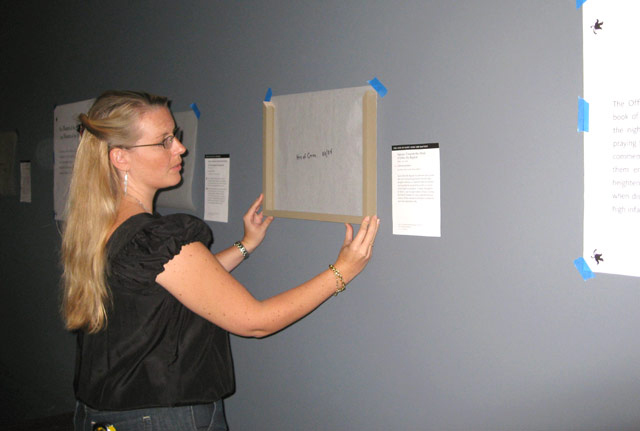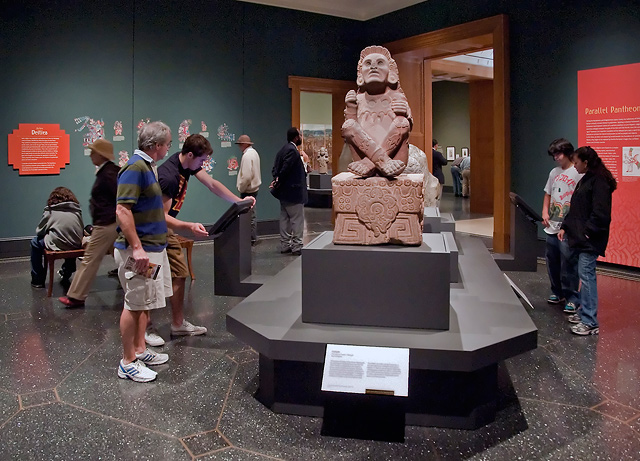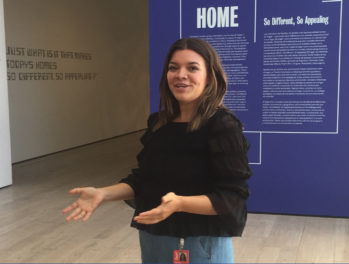
What do you do at the Getty?
I’m a designer. My work includes graphics, or 2-D design, as well as 3-D design-such as furniture, interiors, and architectural drawing. Our department, Design, is unique for a cultural institution because we create 2-D and 3-D in one department.
What are some of the 2-D and the 3-D materials you work with?
2-D materials are graphics and signage—street banners, brochures, table tents, invitations to openings, tickets at the Getty Villa. All these things are branded with a graphic identity.
3-D work includes furniture and case design for the objects we’re displaying, as well as looking at the circulation and flow of an installation space, how many cases we’re going to put into a gallery, how those cases work together, who our audience is, and so on.
What’s your educational background?
I went to Occidental College and graduated in American Studies, then to the Art Center College of Design in Pasadena and studied motion graphics. While I enjoyed motion graphics, I missed working with my hands and seeing a finished product that was tactile. So when I left school, I ended up designing children’s products.
When I came to the Getty, I worked on the Villa Family Forum. It was a nice transition taking children’s materials from one medium to another and looking at them in a three-dimensional space.
The designers within our department come from different disciplines. Some came in as architects, product designers, interior designers, or like me—as graphic designers.

The Family Forum at the Getty Villa
How did you become interested in exhibition design?
You know, I really fell into it. I’d always been interested in 3-D design, and I love a challenge and always hope to try something new. Because our department affords us that experience, we have the best of both worlds: we can try out new things and learn-at the same time that we’re becoming more experienced in things we’re already familiar with.
Do you work at the Getty Center as well as the Getty Villa?
We’re one department at two locations. We take yearly rotations at the Getty Villa, which is really nice for variety, and refreshing your surroundings. There are usually two designers stationed at the Villa out of ten total. We come to the Villa for a year and then we go to the Center for a year.
What are you working on now?
We just took down The Aztec Pantheon, which was a great show in many ways. It was completely different for us and very exciting to work on. It was great to sink your teeth into new material and really experiment.

Installation view of The Aztec Pantheon and the Art of Empire at the Getty Villa. In the background, a wall graphic introducing deities from the Aztec pantheon. In the foreground, an Aztec sculpture of Xochipilli from 1450–51. (Museo Nacional de Antropología, Mexico City. CONACULTA-INAH-MEX © foto zabé. Reproduction authorized by the National Institute of Anthropology and History)
We’re just going into installation for the The Art of Ancient Greek Theater, opening August 26. There are about 100 objects, mostly ancient vases and a few sculptural items.
How are you approaching the The Art of Ancient Greek Theater exhibition?
Being that there are so many pieces in the show, of the same media type, the challenge has been to keep the objects separate and unique, but also presented in manageable groupings. There are groups of vases that are designated to particular themes, for example, which allows them to be read as a unit.
We’ve also manipulated the space a little by using different gallery colors to show that one gallery is comedy, one is tragedy, and one is Dionysos and his actors. One gallery is dedicated solely to a parchment fragment of an ancient play, and in the hallway we’ll have a map of ancient theater sites, which will be a good introduction to the materials presented within the installation.

Foam core mock-up of the galleries for The Art of Ancient Greek Theater
Do you take a different approach to designing a permanent collection gallery than to designing a temporary exhibition gallery?
Very much so! An exhibition usually has a lifespan of three to five months. For permanent collections, you need to design something that will stand the test of time, whereas in an exhibition you can go for something more eye-catching. It affects how you present color, for example. Take Ancient Theater. We’re using very rich navy and magenta. I would never think to put magenta in a permanent installation. (Laughs.)
What personal skills are essential for this job?
Problem solving. Being able to look at any situation and not only think of it with a creative mindset, but also with a willingness to go around the problem completely to figure out a solution.
Thinking quickly on your feet is another skill that comes in handy. In other jobs you might work on a project for a year or two, but here we’re constantly bringing in new material and always educating ourselves about different ideas of presentation, cultures and objects, and how to install them in a refreshing manner. Not to mention keeping up with all the digital applications, too.
You work with a variety of departments at the Getty. Is it a challenge to work with so many people?
It’s a good challenge. Whether it’s education or public programming or curatorial, we’re doing the same job—learning how to communicate with different people and how to interpret and visualize their goals for a project.
Have you had a favorite project at the Getty?
I’d have to say Aztec. I loved it because of the variety of material, and learning about the objects and culture. Getting to go to Mexico City and seeing the objects and where they came from. And the art is just exquisite—it’s hard to go wrong when you’re working with artworks that are so phenomenal!
What’s the best part about your job?
Wow, that’s a tough question! (Laughs.) It’s been a wonderful experience. I’ve been here for over six years, and I really enjoy what we do. It’s constantly changing, constantly evolving, constantly challenging. I’m always up for trying something new.
Besides design, is there any other profession you might have enjoyed?
I would have loved to be a chef. I enjoy food. It’s another creative medium, but even better—it’s one you can eat!





Davina, Good to get an update on you & your interesting work. Pres Hill (Gene’s Mother)